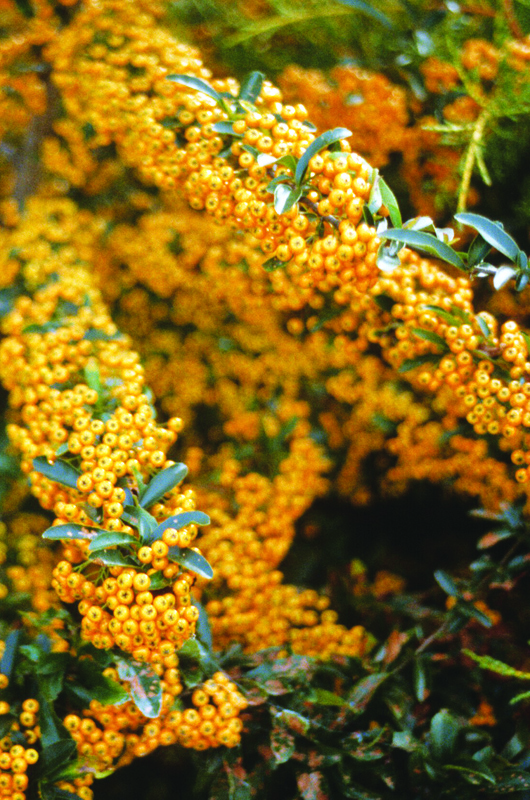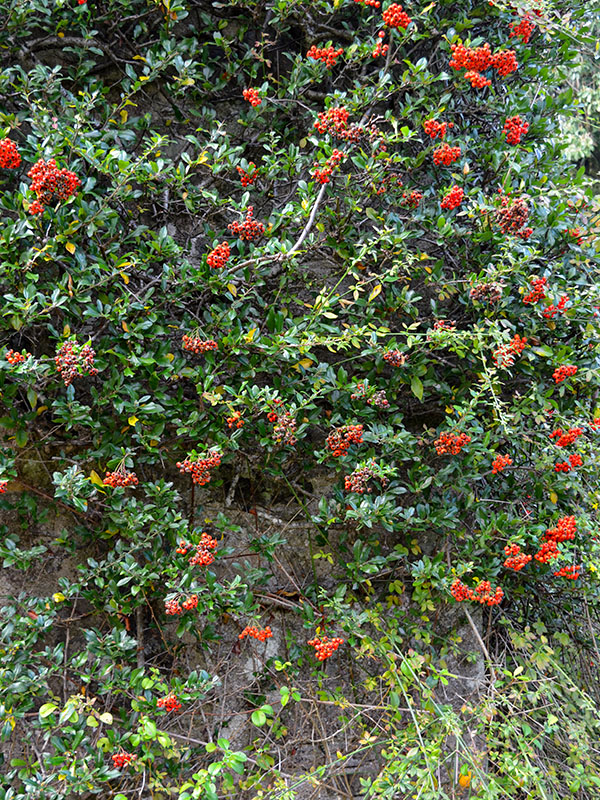
Woody > Pyracantha > Pyracantha coccinea > Pyracantha coccinea
Pyracantha coccinea
Scarlet Firethorn
Mike's
Opinion


"
The best places to grow the Firethorn would be areas that are somewhat protected from winter winds such as along a fence or between buildings. This plant is not recommended for active areas where small children play because of its sharp thorns. The plant does suffer from severe winter burn; I have seen only one decent specimen in Ontario ever!
Michael Pascoe, NDP., ODH., CLT., MSc. (Plant Conservation)
"
| Family |
| Rosaceae |
| Genus |
| Pyracantha |
| Species |
| coccinea |
| Category |
| Woody |
| Type |
| Shrub (evergreen) |
| Pronunciation |
| USDA Hardiness Zone |
| 6-9 |
| Canadian Hardiness Zone |
| 5a |
| Temperature (°C) |
| -25 |
| Temperature (°F) |
| -13 |
| Height |
| 2 - 5 m |
| Spread |
| 2 - 5 m |
Photographs
Description and Growing Information
Flowering Period
| General Description |
| A large evergreen shrub with narrowly slender finely notched leaves. Flowers in June, proceeded by rich red fruits in thick clusters all along the branches. Branching is rigid and will have a more open habit if it is left unpruned. |
| Cultivation |
| When container grown, it is best to re-locate the Firethorn during the early spring to a well drained loamy soil, a soil pH of 5.5 is best. It fruits best in full sun, but can withstand partial shade. Prefers dry soil in the summer. Shelter from strong winds. |
| Shape |
| Upright, open shrub with rigid branching covered in thorns. |
| Growth |
| Fast |
| ID Characteristic |
| Broad leaved barbed evergreen shrub, layered branching, covered in white flowers in June, followed by bright scarlet berries in September and are long lasting. Leaf like stipules at base of some petioles is a distinguishing feature of the Pyracantha. |
| Pests |
| Fireblight and scab are frequent problems for Firethorn. Fireblight can kill the plant. Scab will deform fruit, turning them a brown/black colour. Other issues that can occur are twig blight, leaf blight, root rot, scales, lace bug, and aphids. |
| Habitat |
| Typically found at altitudes of 0 to 4,212 m from Italy to Western Asia. |
| Bark/Stem Description |
| Bark is a glossy, reddish brown colour, and covered in many lenticels. Twigs are initially pubescent, becoming glabrous, red/brown colour with small buds. |
| Flower/Leaf Bud Description |
| Small, rounded, covered in scales. |
| Leaf Description |
| Evergreen, simple, alternate, narrow-elliptic to lanceolate. 2.5-5 cm long on shoots, 1-3.5 cm on flowering shoots. Dark shiny green; bottom leaves are lightly pubescent. Petioles are 0.7cm long, with a downy covering . |
| Flower Description |
| Perfect, creamy white tiny bundles along branches. Open in May, 2.5-5 cm in diameter, 5-7.5 cm long; Compound corymbs inflorescences on spur shoots along the stem of last year’s growth. Fetid subdued odour. Flowers cover entire shrub. |
| Fruit Description |
| Fruit are small rounded drupes, 0.5 cm wide, orange-red in colour. Fruit matures around August - September and usually persists into the winter. |
| Colour Description |
| Glossy dark green in the summer; can become brown in colour if left unprotected from drying winds. If in a sheltered area, the colour will remain a dark glossy green. |
| Texture Description |
| Medium textured foliage. |
| Notable Specimens |
| There is a spectacular espalier specimen of the cultivar ‘Chadwickii” at the Royal Botanical Gardens in Burlington, Ontario, Canada in their courtyard area. Niagara Parks Botanical Gardens, Niagara Falls, Ontario, Canada |
| Propagation |
| Softwood clippings taken under mist in the summer will root easily. IBM treatment of 1000 to 3000 ppm accelerates rooting. Propagates from seed, seed raised plants have inconsistent fruit quality. Stratify seed for 90 days at 5°C. |
References
Parkway Gardens, London, Ontario.




